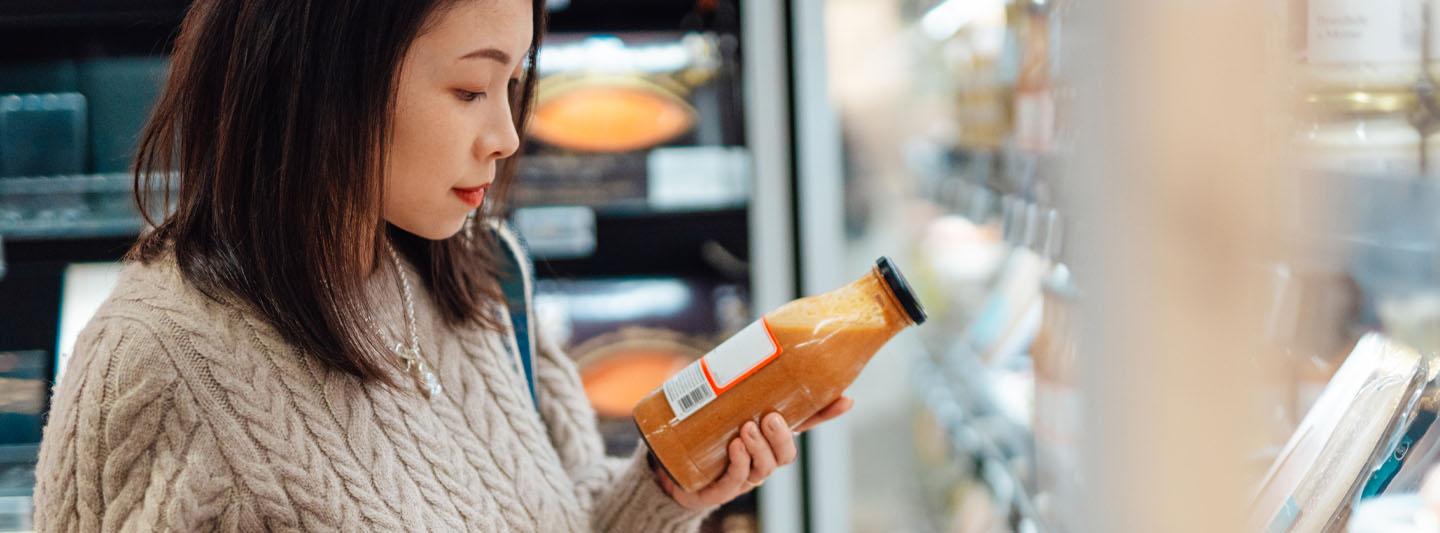Understanding food labels and nutrition lists
Learn more about what the labelling can tell you about a food’s nutritional value and ingredients, along with specifics to look out for on the packaging.
Sophie Bertrand, Msc, RNutr
Nutrition Specialist
Andrea Givens, MS, RD, CSSD,
Medical Affairs
Published
May 07, 2025
Read time
5 minutes

Food labelling tells us how much carbohydrate, fat, and protein is in a product, as well as the amount of fibre, and certain micronutrients
Ingredient lists reveal what components are present in the food, with the ordering of the list showing which ingredients form the largest percentages of the product.
Food labels can help give a sense of how a product might affect your glucose levels, by showing you how much sugar is present as well as other key nutrients like fibre and protein.
Start Lingo today for just £59
Learn how your body responds to food and exercise with a 2-week plan*, no commitment.
Buy now
Food labelling is there to help us stay informed about the ingredients that go into the foods we are consuming. But with so much information on one package, it can sometimes be overwhelming and confusing.
In this article, we’ll look at what you can find out from the labelling on food packaging and how you can use that information to decide which foods may better support your health when you’re out shopping.
‘Traffic light’ scores
In the UK, although not compulsory, food packaging will often include a traffic light colour system to show whether a food has high, medium, or low amounts of fat, saturated fat, sugars, and salt. It can be a useful way to quickly compare nutrient content between products, but be sure to note whether the information is written per 100 grams (g) or portion so you can compare like for like.
The general idea is that you choose products that have more greens (low) and ambers (medium) and fewer reds (high).
Here’s what the colours mean:
Green: A food with mostly green on the label is a healthier choice.
Amber: A food with mostly amber on the label contains medium amounts of certain nutrients and can be eaten most of the time.
Red: A food with red on the label is high in a nutrient and should be eaten less often and in smaller amounts.
However, the traffic light system doesn’t tell you anything about the source or quality of the ingredients. To work this out, you’ll need to do a little more digging and check the ingredients list.
For example, if the fat content of a product is red but the first ingredient on the list is something like nuts or avocado, the fat content is likely coming from these natural sources and providing you with a dose of monounsaturated fat (a healthy fat).
Nutrition information and portion sizes
The back of a food packet will give you more of a nutritional breakdown of the product than the front. This is where you can find the number of calories, total fat, saturated fat, carbohydrates, sugars, fibre, protein, and salt in either a “portion” of the product or per 100 g.
Tip: Be sure to check how much a suggested portion is. Sometimes it may be a lot smaller than you would expect, especially when it comes to prepackaged drinks and snacks.
You may also come across a column with % Reference Intakes (RIs). This column shows you what percentage of your reference intake is in a portion of the product. Reference intakes are guidelines about the amount of a nutrient that is enough to ensure that the needs of nearly all (97.5%) adults are being met.
The nutrient breakdown and %RIs can often help you decide between two different products. If you’re wanting to eat something that will have less of an impact on your glucose, you may want to choose the option that has the most fibre or protein, as these can help slow the absorption of glucose to your bloodstream.
Nutrition and health claims
Nutrition claims relate to what a product does or doesn’t contain or contains in a high or low amount.
For example: 1
Sugar free — must contain less than 0.5 g sugars per 100 g
Low fat — must contain less than 3 g fat per 100 g
High in fibre — must contain at least 6 g fibre per 100 g
Source of vitamin D — must contain at least 15% of the RI for vitamin D per 100 g
Tip: Products that have “low fat” on their packaging often contain extra sugar. Manufacturers add this to make up for the change in taste that comes from having less fat.
Health claims are claims that state or suggest there is a relationship between a product and your health.
For example:
Calcium is needed for the maintenance of normal bones.
Potassium contributes to the maintenance of normal blood pressure.
Vitamin C contributes to the reduction of tiredness and fatigue.
Folate contributes to maternal tissue growth during pregnancy.
Health claims on food labels are not allowed to state that the food can prevent, treat, or cure any disease or medical condition. They’re also not allowed to refer to a specific rate or amount of weight loss.
Ingredients lists and sugar
The ingredients list always appears in descending order by weight. For example, if the first ingredient is oats then the largest proportion of the product is made from oats, followed by the next largest, and so on.
You may notice the first ingredient on some foods like breakfast cereals is sugar. This means that much of the product is made with sugar.
If you’re trying to support healthy glucose levels, it's helpful to be clued up when it comes to reading food labels and identifying the different names that sugar might fall under. Products high in sugar can be more likely to cause glucose spikes.
Here are some different names for sugar that may be easy to miss if you’re not aware of them:
Maltose
Sucrose
High fructose corn syrup
Fructose
Cane juice
Agave syrup
Honey
Maple syrup
Coconut nectar
All of these ingredients listed above are a form of sugar and are likely to result in a glucose spike when eaten alone or in large quantities.
Experts recommend eating no more than 30 g of free sugars per day, as high sugar intake has been linked to poorer health outcomes.2 Free sugars include added sugars as well as the natural sugars you find in syrups, honey, and fruit and vegetable juices.3
U.K. food labels do not list "free sugars" separately. Instead, they display the total sugar content, which includes both naturally occurring sugars and added sugars (considered "free sugars") on the nutrition label.
Here’s what to look for when you’re searching for a food that is low in free sugars:
Sugar (or a different name for sugar) is not one of the first few ingredients on the ingredient list.
The colour for sugars on the traffic light label is green.
There is less than 5 g of total sugars per 100 g.
You do not need to completely avoid foods containing these ingredients and they can be enjoyed sparingly as part of a healthy, balanced lifestyle, but it's important to be aware of these hidden sugars and where they might be unintentionally sneaking into your diet, allowing you to make conscious choices for your wellbeing. Sugars can often be added to foods that you may not expect, like peanut butter, sauces, dressings, and other condiments, so be sure to check their labels.
You’ll be able to see how these foods can affect your glucose with a continuous glucose monitor (CGM) like Lingo. These devices can provide data to show you the impact of your eating habits, giving insights to help you discover which foods might work for you.
Tip: Try consuming foods containing sugar after a balanced meal of vegetables, protein, and healthy fats, which may help to decrease the impact on your glucose level.
All this doesn’t mean you have to avoid your favourite chocolate or dessert. Even if you buy a high-sugar food, you can always use the tips Lingo gives you to reduce the spike those foods are more likely to cause.
A final note from Lingo
To keep your glucose steady, it's important to prioritise a balanced diet with plenty of fibre-rich veggies as well as protein and healthy fats.
Keeping an eye on portion sizes as well as moving after meals can also help reduce your post-meal glucose.
And finally, slow down and enjoy your food. You can learn to enjoy the foods you love in a way that reduces the impact on your glucose and maximises the impact on your health.
You can track your glucose using a CGM like Lingo and use the personal data it provides to help inform how you approach your favourite foods.
The Lingo system is not for medical use and intended for users 18 years and older. Lingo is not intended for diagnosis or management of any disease including diabetes.
The Lingo programme does not guarantee that everyone will achieve the same results as individual responses may vary. It is best to speak to your doctor for advice on starting any diet or exercise regime or if you have an eating disorder or a history of eating disorders.
© 2025 Abbott. All rights reserved. The biosensor shape and appearance, Lingo, and related brand marks are marks and/or designs of the Abbott group of companies in various territories. Other marks are the property of their respective owners.
ALB-02634
Published
May 07, 2025
Read time
5 minutes


Sophie Bertrand, MSc, RNutr, is a contributing nutritionist at Lingo. She is a Registered Nutritionist with the Association for Nutrition (AfN) and has been awarded both a BSc in Psychology from Regents University London and an MSc in Nutrition from University College London. With over 8 years in the health and wellness industry, Sophie has consulted for several brands and companies in the food and health space.


Andrea Givens MS, RD, CSSD, is a Senior Medical Affairs Specialist and Health Coach at Lingo. Andrea has a passion for empowering individuals to leverage their unique physiology to optimise performance and health. She’s been a registered dietitian since 2010 and has been a board-certified specialist in sports dietetics since 2017. She holds master's degrees in both nutrition science and exercise physiology from San Diego State University.
A healthy choice for your inbox
Sign up for Lingo emails to get science-backed tips, special offers, and The Journey Newsletter.
Start Lingo today
for just £59
Learn how your body responds to food and exercise with a 2-week plan*, no commitment.
- 1 Lingo biosensor with minute-by-minute continuous glucose tracking
- Full access to the Lingo app. Designed for iPhone 11 device or later.
Shop now
Free shipping
*No commitment. This plan does not auto-renew (requires an iPhone 11 or later)

